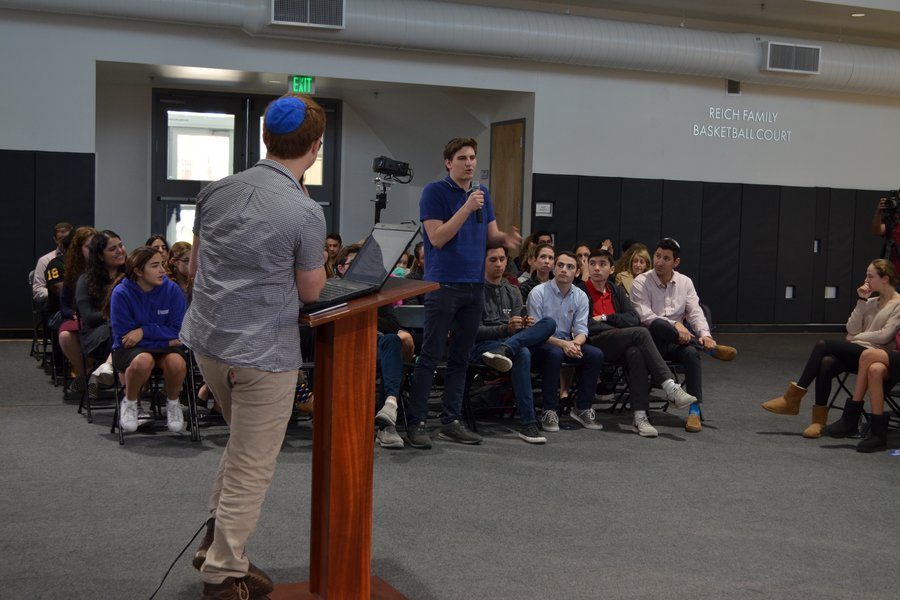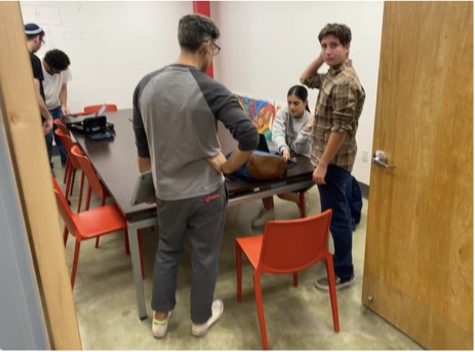Votes keep no-lunch Fridays, change boys dress code
Boys with fringes out may wear t-shirts and early dismissal will continue for the rest of the year
CHANGE: Agenda Chair Daniel Lorell heard a comment from senior Rami Gruman at Town Hall.
Schedule:
The Just Community voted on Jan. 4 to continue no-lunch and early dismissal on Fridays, guaranteeing that school will end at 12:45 p.m. on Erev Shabbat for the rest of the year.
Students and faculty voted last spring to make the change, but administration chose to have an eight-week trial period for the new schedule.
The trial period apparently went well, because the overwhelming majority of the Shalhevet community — 86 percent — has now voted to keep it. Last year, school ended Fridays at 1:15.
“I love the new Friday schedule,” said sophomore Mitchell Hoenig after the vote. “It gives me time to actually enjoy life more when Shabbat starts later.”
At the end of last year, then-junior Amin Lari introduced a proposal to get rid of lunch on Fridays and end school earlier so people would have more time to prepare for Shabbat, and to save the extra expense of pizza. Pizza is still served to those who sign up for it, around 70 students according to lunch coordinator Muriel Ohana.
When it was voted on last spring, Agenda Chair Daniel Lorell shared that YULA Boys ends at 1:05 p.m. with an optional lunch, and YULA Girls at 12:45.
“In schools that have an Orthodox or Modern Orthodox population like we do…, they feel that ending school much earlier on Fridays — like at a time like this when Shabbat comes in much earlier — is an acceptable choice to make,” Daniel said before the vote.
Not only has the new schedule given students more time to prepare for Shabbat, but it also has eliminated the short lunch break before last period, which some students felt was unnecessary.
“I always found that 30-minute break before the last period seemed a little weird, so taking that out seemed way more convenient,” Amin said.
“I like this new schedule so much more,” he added. “We can see here that the Just Community works.”
Dress code:
Male students can now wear non-collared shirts to school, provided they wear tzitzit underneath with the fringes out, after a proposal by seniors Eitan Remer and Jonathan Fishman was passed at Town Hall Sept. 28.
Eitan and Jonathan said they wanted to incorporate the religious values of Shalhevet while accommodating boys’ wish to be comfortable at school. The Shalhevet handbook requires tzitzit, but states faculty members won’t perform checks.
With this, Eitan and Jonathan came up with an idea. They called it “tzitzit over collar,” meaning boys who wear tzitzit out wouldn’t need to wear a collar, and would still be in dress code. That creates an incentive to wear tzitzit that wouldn’t otherwise exist.
“Shalhevet is not going to check for tzitzit, and boys don’t need to wear tzitzit, so there needs to be something that will make the boys want to wear tzitzit,” Jonathan said at the Town Hall.
“We made this proposal because everyday there is a very minuscule percentage of the boys’ student body wearing tzitzit, and we wanted to get more boys to wear more tzitzit.”
Eitan added on to what the rule would be with the new dress code.
“If and only if a boy is wearing tzitzit, a boy can wear a hoodie, a sweatshirt, or a normal long sleeve shirt without a collar,” Eitan said — all garments that were forbidden before.
The Student Handbook states, “As an Orthodox Jewish school, all boys should wear tzitzit. However, Shalhevet will not conduct physical checks.”
Students and faculty are enjoying the results of the new dress code.
“This new dress code allows students to be comfortable with what they’re wearing and the increase of encouragement to wear tzitzit,” said sophomore Joseph Klores. “I also like how it was a fair value trade off between the students and faculty.”
Rabbi Ari Schwarzberg commented from a faculty perspective on how the new dress code has been going.
“Generally it’s going really well,” he said. “There have only been a few cases where people are violating the dress code, but overall I think everyone is on board.”

Shayna Becker started working for the Boiling Point during her first semester at Shalhevet and has gradually become more involved in reader engagement, through brainstorming out-of-the-box ways to best target BP’s viewers and readers through social media, advertising and more. Shayna is dedicated to add more creativity and interactive content to the paper, and is eager to get the job done! If she's not in the news office, you can find her in the halls talking up a storm with just about anyone.











